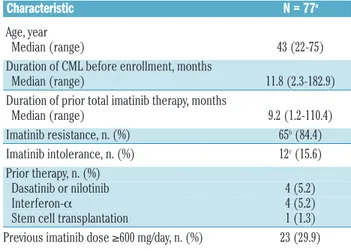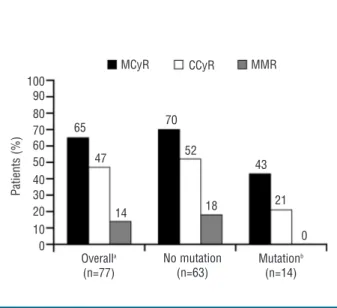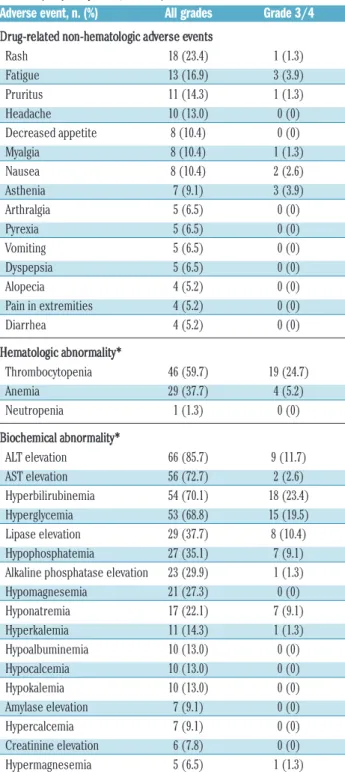Introduction
Chronic myeloid leukemia (CML) is characterized by the presence of the Philadelphia chromosome, which forms as a result of a reciprocal translocation between chromosomes 9 and 22 and leads to production of the BCR-ABL1 fusion pro- tein.
1,2The first BCR-ABL1 tyrosine kinase inhibitor, imatinib, has been recommended for the first-line treatment of chronic phase CML and has dramatically improved survival rates since its introduction.
3,4Nonetheless, some patients with chronic phase-CML have shown imatinib resistance, in most patients due to mutation in BCR-ABL1 that affects the ima- tinib binding site.
5-7Additionally, some patients have devel- oped intolerance due to adverse events associated with ima- tinib treatment.
8-10In an attempt to overcome imatinib resist- ance, 2
nd-generation tyrosine kinase inhibitors were devel-
oped, including dasatinib, nilotinib, bosutinib, and pona- tinib.
11-14However, the costs of 2nd-generation tyrosine kinase inhibitors may be prohibitive, particularly in emerging regions such as the Asia-Pacific countries, and new, lower cost alternatives are necessary.
15-18Radotinib (Supect™; C27H21F3N8OHCl, 4-Methyl-N-[3- (4-methyl-imidazol-1-yl)-5-trifluoromethyl-phenyl]-3-(4- pyrazin-2-yl-pyrimidin-2-ylamino)-benzamide hydrochlo- ride; IL-YANG Pharm. Co. Ltd., Seoul, Korea) is an oral tyro- sine kinase inhibitor.
19In vitro, radotinib binds BCR-ABL1 and reduces phosphorylation of CrkL, a BCR-ABL1 target protein.
Furthermore, pre-clinical studies demonstrated superiority of radotinib to imatinib in both wild-type and mutant BCR- ABL1 positive CML cell lines.
20In a phase I clinical trial, no dose-limiting toxicities were observed with a dose of up to 1000 mg/day.
21This study evaluated the efficacy and safety of
©2014 Ferrata Storti Foundation. This is an open-access paper. doi:10.3324/haematol.2013.096776 The online version of this article has a Supplementary Appendix.
Manuscript received on August 15, 2013. Manuscript accepted on March 31, 2014.
Correspondence: dwkim@catholic.ac.kr
Radotinib (IY5511HCL), a novel and selective BCR-ABL1 tyrosine kinase inhibitor, has shown pre-clinical and phase I activity and safety in chronic myeloid leukemia. This phase II study investigated the efficacy and safety of radotinib in Philadelphia chromosome-positive chronic phase-chronic myeloid leukemia patients with resistance and/or intolerance to BCR-ABL1 tyrosine kinase inhibitors. Patients received radotinib 400 mg twice daily for 12 cycles based on results from the phase I trial. The primary end point was rate of major cytogenetic response by 12 months. A total of 77 patients were enrolled. Major cytogenetic response was achieved in 50 (65%; cumulative 75%) patients, including 36 (47%) patients with complete cytogenetic response by 12 months. Median time to major cytogenetic response and complete cytogenetic response were 85 days and 256 days, respectively. Major cytogenetic response and complete cytogenetic response rates were similar between imatinib-resistant and ima- tinib-intolerant patients, but were higher in patients without BCR-ABL1 mutations. Overall and progression-free survival rates at 12 months were 96.1% and 86.3%, respectively. All newly-occurring or worsening grade 3/4 hematologic abnormalities included thrombocytopenia (24.7%) and anemia (5.2%); grade 3/4 drug-related non- hematologic adverse events included fatigue (3.9%), asthenia (3.9%), and nausea (2.6%). The most common bio- chemistry abnormality was hyperbilirubinemia (grade 3/4 23.4%), and 12 of 18 cases were managed with dose modification. Study findings suggest radotinib is effective and well tolerated in chronic phase-chronic myeloid leukemia patients with resistance and/or intolerance to BCR-ABL1 tyrosine kinase inhibitors and may represent a promising alternative for these patients. (clinicaltrials.gov identifier: 01602952)
Efficacy and safety of radotinib in chronic phase chronic myeloid
leukemia patients with resistance or intolerance to BCR-ABL1 tyrosine kinase inhibitors
Sung-Hyun Kim,
1Hari Menon,
2Saengsuree Jootar,
3Tapan Saikia,
4Jae-Yong Kwak,
5Sang-Kyun Sohn,
6Joon Seong Park,
7Seong Hyun Jeong,
7Hyeoung Joon Kim,
8Yeo-Kyeoung Kim,
8Suk Joong Oh,
9Hawk Kim,
10Dae Young Zang,
11Joo Seop Chung,
12Ho Jin Shin,
12Young Rok Do,
13Jeong-A Kim,
14Dae-Young Kim,
15Chul Won Choi,
16Sahee Park,
17Hye Lin Park,
18Gong Yeal Lee,
18Dae Jin Cho,
18Jae Soo Shin,
18and Dong-Wook Kim
17,191
Dong-A University Medical Center, Busan, South Korea;
2Tata Memorial Hospital, Parel, Mumbai, India;
3Faculty of Medicine,
Ramathibodi Hospital, Mahidol University, Bangkok, Thailand;
4Prince Aly Khan Hospital, Mazagaon, Mumbai, India;
5Chonbuk
National University Medical School & Hospital, Jeonju, South Korea;
6Kyungpook National University Hospital, Daegu, South Korea;
7
Ajou University Hospital, Suwon, South Korea;
8Chonnam National University, Hwasun Hospital, Hwasun, South Korea;
9Kangbuk
Samsung Hospital, Sungkyunkwan University School of Medicine, Seoul, South Korea;
10Ulsan University Hospital, Ulsan, South
Korea;
11Hallym University Sacred Heart Hospital, Anyang, South Korea;
12Pusan National University Hospital, Pusan, South Korea;
13


